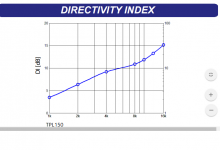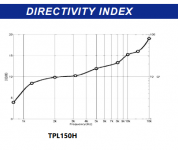Last night I've aligned my tweeter to mid using generated tones (3 cycles 3850Hz) and a impulse.
One speaker has Seas 27TDC in P-audio PH-170 horn. One speaker has BMS 4524 in the same P-audio PH-170 horn.
I could clearly see that the Seas had much more trouble following the input signal. It rested later and the start was preceded by some sort of ringing.
I like the Seas but this BMS sounds very good at low volume (and high..).
One speaker has Seas 27TDC in P-audio PH-170 horn. One speaker has BMS 4524 in the same P-audio PH-170 horn.
I could clearly see that the Seas had much more trouble following the input signal. It rested later and the start was preceded by some sort of ringing.
I like the Seas but this BMS sounds very good at low volume (and high..).
The compression drivers usually measure worse above 10k but will crush any dome in clean output if you want anything resembling live dynamics.
The newest compression drivers are very nice. Eighteen Sound products in particular look very good.
I'd really like to see some measurements backing that up. Not saying you are wrong but that's why i'd like to see one guy measures known CD/WG combo and dome tweeter with the same measuring equipment at the same loudness. Comparing or looking at different measurements scattered on the web doesn't say much about relations between them.
That's why i gladly visit audiogurman.com and zaphaudio.com - all measurements are done by one guy, in same conditions and with same measuring tools so relations between that measurements matter.
Last edited:
I found something.
Measurements done by Kimmo Saunisto.
18sound ND1095/XT1086 at 90dB
Vifa XT25TG30/Monacor WG300 at 90dB
Monacor DT300/Monacor WG300 at 90dB
Seas 27TBFC/G/Monacor WG300 at 90dB
Measurements done by Kimmo Saunisto.
18sound ND1095/XT1086 at 90dB
An externally hosted image should be here but it was not working when we last tested it.
Vifa XT25TG30/Monacor WG300 at 90dB
An externally hosted image should be here but it was not working when we last tested it.
Monacor DT300/Monacor WG300 at 90dB
An externally hosted image should be here but it was not working when we last tested it.
Seas 27TBFC/G/Monacor WG300 at 90dB
An externally hosted image should be here but it was not working when we last tested it.
Last edited:
Last night I've aligned my tweeter to mid using generated tones (3 cycles 3850Hz) and a impulse.
One speaker has Seas 27TDC in P-audio PH-170 horn. One speaker has BMS 4524 in the same P-audio PH-170 horn.
I could clearly see that the Seas had much more trouble following the input signal. It rested later and the start was preceded by some sort of ringing.
I like the Seas but this BMS sounds very good at low volume (and high..).
Interesting as this Seas driver is not a bad driver...
I could clearly see that the Seas had much more trouble following the input signal. It rested later and the start was preceded by some sort of ringing.
FWIW, way back when, I never had any luck horn loading soft dome mids/tweeters except in relatively large WGs that put little pressure on them, so basically were only good for small short WGs that's become popular on studio monitors, etc., in the last decade or so.
GM
Right, needs to be designed for at least a ~2 kHz/2nd order XO to do 20 kHz 'clean' and ~5 kHz at high power and ~8.3 kHz at peak efficiency.
GM
Hi GM,
Do compression drivers à là JBL D2 or BMS alike perform in this range as good as a dedicated 1" ?
Or is it not as good because it's hard to make a horn performing well from around 800/1000 Hz to 18000/2000 K Hz with these "double" compression drivers ?
(I think of course about a M2 JBL speaker : 2 ways or maybe synergies with 1" at the apex which are XOed a little higher if I don't mistake : often around 1500 Hz)
Here is Zaph's look "study" into shallow waveguides that are better designed for the dome tweeter (and properly mounted to avoid a resonant and diffractive condition at the entry ..and exit/interface with baffle):
Zaph|Audio
Note that the driver is the same Seas unit..
Also note the difference between the driver with a high pass filter, and without with respect to harmonics/non-linear distortion.. (..it should help to explain why Kimmo's results look bad for domes without a high pass filter when compared to a compression driver without one, though with the compression driver having a "natural" more exaggerated pressure loss at lower freq.s.)
Zaph|Audio
Note that the driver is the same Seas unit..
Also note the difference between the driver with a high pass filter, and without with respect to harmonics/non-linear distortion.. (..it should help to explain why Kimmo's results look bad for domes without a high pass filter when compared to a compression driver without one, though with the compression driver having a "natural" more exaggerated pressure loss at lower freq.s.)
Last edited:
FWIW, way back when, I never had any luck horn loading soft dome mids/tweeters except in relatively large WGs that put little pressure on them, so basically were only good for small short WGs that's become popular on studio monitors, etc., in the last decade or so.
GM
Not about dome, but I liked (although not listen to) what Weltersys or xrq971 members did by horning a "Full range" 2.5" CONE... but Something in the highs is missing if I understood (maybe here a ribbon > 10 k Hz would help as the center to center spacing is not so important at that highs XO: my understanding from an old answer from ScottL about his system iirc)
@ ScottG :
 (thanks for the link, I didn't remember of this review at Zaph's pages)
(thanks for the link, I didn't remember of this review at Zaph's pages)
Last edited:
I'd really like to play with compression drivers that's been upgraded with Be diaphragms.
Bwaslo member have some esteem for this much much cheaper one (coated titanium .... polymer surfacing get away the ringing : > 20 K Hz ?)
https://www.parts-express.com/pedocs/specs/264-1420--tymphany-dfm-2535r00-08-spec-sheet.pdf
Some devices like Beyma's AMT TPL150 comes in two flavors, with a wave guide ( TPL150H) or without, direct radiator, TPL150.
Though their axial response can be equalized to the same flat response, and both devices have similar sensitivities, they do not sound the same, the direct radiator sounding more open and airy, while the H version sounds duller.
Maybe looking a their respective DI curves we can find the reason why...
To high a DI too soon ( 1khz) and to high ( >10dbs) at 10khz and above, maybe is a sacrifice to coverage useful in PA use, but HIFI use requires imho more softer and progressive numbers, more similar to those recommended/used by Toole, Geddes, or found in products like pro monitors by Genelec.
Maybe for an outdor sono power response does not matter, but in a small room i think it does, and of the shelf pro wave guides usually show to excessively high DIs to be used for HIFI. An Econowave is NOT an M2 or a Suma...
Though their axial response can be equalized to the same flat response, and both devices have similar sensitivities, they do not sound the same, the direct radiator sounding more open and airy, while the H version sounds duller.
Maybe looking a their respective DI curves we can find the reason why...
To high a DI too soon ( 1khz) and to high ( >10dbs) at 10khz and above, maybe is a sacrifice to coverage useful in PA use, but HIFI use requires imho more softer and progressive numbers, more similar to those recommended/used by Toole, Geddes, or found in products like pro monitors by Genelec.
Maybe for an outdor sono power response does not matter, but in a small room i think it does, and of the shelf pro wave guides usually show to excessively high DIs to be used for HIFI. An Econowave is NOT an M2 or a Suma...
Attachments
Last edited:
Shallow waveguides are generally more forgiving. What do you find different about the needs of a dome tweeter compared to the needs of a compression driver?shallow waveguides that are better designed for the dome tweeter
Generally true, but probably no more so than saying something like: a DI plot indicates the profile of the horn..High DI delivers more of the recording/music, low DI delivers more of the room/reflections.
I am talking about listening to the speaker in the room and it's radiation not some manufactures graph.
Room response relates to power response, which inversely relates to DI trend.
What you hear is indeed the DI, more exactly the contrast between axial response/direct sound and power response/reverberated sound.
Some defend the idea that both need to be similar, others that the room is the evil.
It's a free world, for the moment...
Shallow waveguides are generally more forgiving. What do you find different about the needs of a dome tweeter compared to the needs of a compression driver?
The compression driver exits at something approaching 0 degrees (..with very few having as much as 30 degrees "shaped" from that with a longer exit "tube" and more progressive expansion).
An average dome tweeter isn't like this at all - it's usually designed for a flat baffle or what is a 90 degree path (..though often domes will have very small wavequides integrated into their front plate for freq.s above 15 kHz).
Sticking a dome tweeter into a horn designed for a compression driver add's in substantive diffraction, particularly as the diffraction of the mouth concentrically resonates back to the entry - disturbing the higher freq. response. This might even modulate the diaphragm of the dome where the dome's structure isn't particularly ridged.
Additionally, there is often a problem of getting the right fit for the dome tweeter (particularly with its roll surround) - which again has diffractive, reflective, and resonant issues. While this can also be a problem for compression drivers mounting to any given horn, it's far more likely to be a problem with mating the horn to the tweeter. (..Zaph goes into this a bit.)
Of course each dome shape/size is going to be a bit different - my guess is that an "optimal" depth would likely be somewhere between 1-1.75 inches depending on the diameter of the waveguide (assuming a diameter as large as 12 inches). I think another benefit with a shallow depth might be that you could "cut into" the waveguide for the complementing midrange/midbass to get acoustic centers closer vertically than what the waveguide's near half diameter would suggest (..though you would still need to make sure that mid's frame and surround presented a smooth surface extension of the waveguide).
I should also note that if you want more information: PM Dave Pellegrene - he's the one with all the practical knowledge on the subject of domes and waveguides.
Last edited:
- Status
- This old topic is closed. If you want to reopen this topic, contact a moderator using the "Report Post" button.
- Home
- Loudspeakers
- Multi-Way
- Treble range : compression driver vs others

